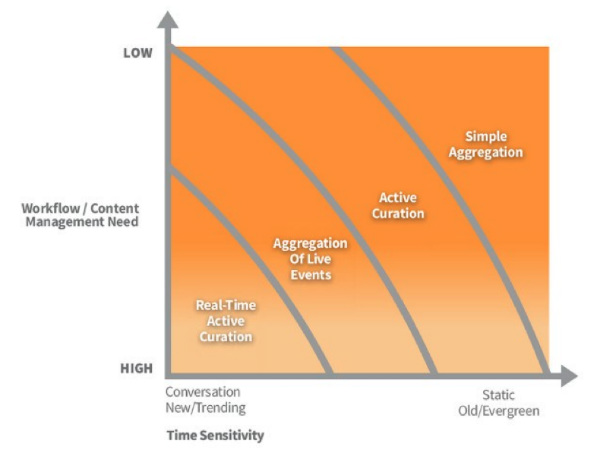5 Content Curation Roles for a Streamlined and Effective Workflow
In order for content curation to be truly effective, it should be treated like any other major aspect of your content marketing strategy: purposefully, with designated roles and tasks for those involved.
However, given that curation as a strategic pillar is still in its relatively early stages of adoption for many brands, this structure and personnel support has not been widely discussed.
Whether you are a Team of One responsible for developing and implementing a new content curation strategy in addition to your other duties or if you have multiple teammates assigned to tackle the job together, it can be helpful to outline an ideal process and set of responsibilities to make the most of your curation efforts.
As the need for active curation grows, it is becoming increasingly critical to create a plan for what content should be curated, from where it should be sourced, and how often and where it should be shared on social media, email newsletters, or on a website.
With an agreed upon “curation blueprint” in place, it becomes easier to test and optimize the content curation workflow for more meaningful engagement and, therefore, a stronger return on investment.
To illustrate, Content Marketing Institute created this graph showcasing how, as brands move away from simple aggregation tactics and toward more real-time active curation, there is an increase in the need for more content management and a structured workflow.

Even if you don’t have the team or technology in place to operate from the highest level of active curation just yet, implementing any sort of strategic workflow will still help create efficiencies and allow for batch tasking.
Here’s a short list of team tasks that help to form the foundation to a successful curation process:
- Create a list of relevant topics that the target audience would find valuable
- Develop specific keywords and phrases for each topic to utilize as search criteria during the curation process
- Determine what standards a piece of content must meet in order to be considered
- Define what successful curation looks like and the metrics needed to track this success
- Agree upon a posting schedule for curated content that includes which platforms and their respective frequencies
- Create a schedule and process for curating to consistently meet posting timeline
- Assign role(s) and responsibilities to each team member
- Identify who else might need to be consulted for approvals outside of the curation team
- Review analytics for engagement to note what is working and what isn’t and adjust accordingly
If you do have a team, it’s important to involve each individual in these tasks to encourage buy-in and eliminate future misunderstandings that could otherwise arise.
With a solid foundation in place, it’s time to carry out that plan!
Below, you’ll find a list of curation roles that can be assigned to team members for the maximum return on your curation efforts.
Remember, these are roles, not necessarily specific staff positions, and therefore, they might be filled by one person or multiple people.
Bonus: Scroll down to access our free workbook to help your content curation team establish an effective workflow

Content Strategist
This individual, usually at the director or manager level, takes a more macro approach to content, questioning where it all fits into the larger strategy and if current methods are sustainable and effective.
He or she works closely with both the creative and curation teams (often the same group of people) to ensure that all content, both third-party and original, aligns in terms of quality, type, topic, and timeliness.
They regularly check in with each role to see what’s working, what isn’t, and how the audience is resonating with the content curated, providing a loop of continual feedback so tweaks can be made.
As Ann Handley writes, it’s “worth noting that this person doesn’t touch any content. They don’t create or produce much content at all.
But, that said, please hire a content strategist who nevertheless does create content on a regular basis.
Producing content might not be a part of his or her current job description, but content creation is still so much in their DNA that they can’t help themselves.”
In this same fashion, this individual may not be required to curate regularly, but given their involvement in the process, they may just as well cast their own vote about what third-party content should be curated here and there. It’s too tempting not to.

Content Scout
The Content Scout handles the logistics of identifying where to source content from and organizes these sources into one list and/or selects the content discovery tool that best suits the team’s needs.
If the team uses a tool or conducts research for curated content, the Scout is responsible for implementing the agreed upon search criteria determined by the entire curation team.
This person is always listening for information and resources that might better serve the intended audience.

Curator
Often not a separate role, but rather one part of the other roles above and below, the Curator (or Curators!) accesses the sources the Content Scout has identified, skims headlines, and narrows the content to a list of potential options.
He or she then reads the content and determines whether or not it meets the criteria required for sharing, as set by the entire curation team.
If the piece of content passes the test, the Curator makes note or flags it for use by the Distributor.

Distributor
This individual, also sometimes referred to as a Syndicator, reviews the content selected by the Curator and distributes it to the appropriate channels at designated times to maximize impact and engagement, considering timeliness around holidays, events, and news.
When distributing to these channels, he or she does not simply share a link and a headline, but instead, customizes the message by adding a unique perspective, providing feedback, asking a thought-provoking question, and/or tagging the original source.
He or she is skilled at working with social media scheduling tools like Hootsuite and Buffer and often batches this sharing for one chunk of time to make the best use of their time.
Again, this role is typically a part of other responsibilities.

Community Manager
The Community Manager spends time in the channels and platforms where curated content has been distributed.
This person interacts with the communities there, following up with those who have engaged with the content that has been curated and facilitating new conversations to build a loyal, interested audience.
He or she then reports back to the Content Strategist and team on which content is performing best.
This person is an expert at multitasking and having personable conversations with any and all people.
As with any group who is in the early stages of development, it may take some adjusting and communicating to find a flow that works best for your team, but by understanding what is involved in each step of a successful curation process, teams can develop a strategy that works, without cutting corners along the way.
It also provides the visibility needed to A/B test different parts of the process, so that improvements can continue to be made on a monthly, quarterly, and yearly basis.
If you are a Team of One, take heart!
You are likely doing all of these responsibilities already, but organizing your workflow around these roles helps to see where you can continue to improve or expand.
Now you can streamline your process even further and take note of what areas you tend to excel in for consideration in bringing on future teammates.
Want to make sure every member of your curation squad knows what they are responsible for and get a jump start on the foundation to your strategy?
Download our free workbook that includes a checklist for each role with exercises your team can complete together to develop an effective workflow.



